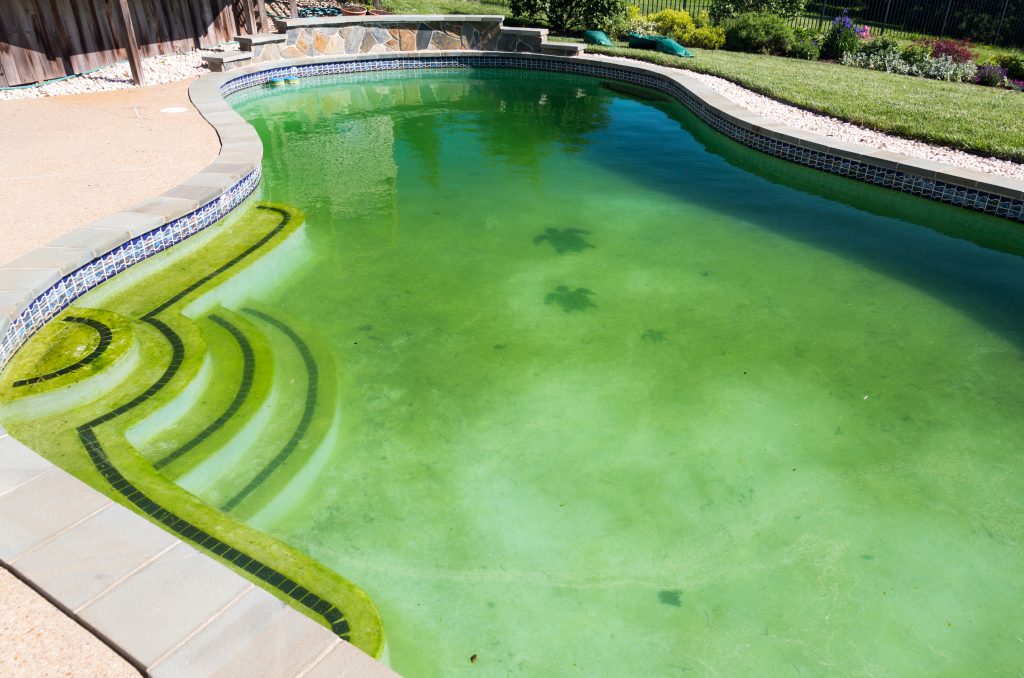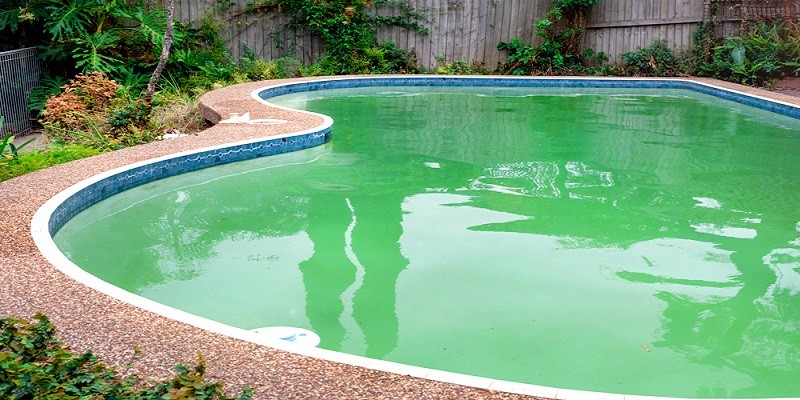To clean a green pool, first, balance the water’s chemistry with proper chemicals and adjust the ph levels. Then, shock the pool to kill and remove algae, followed by brushing the pool walls and floor to loosen and remove any remaining debris.

Credit: www.handypools.com.au
The Causes Of A Green Pool
Keeping your pool water crystal clear and inviting is essential for a refreshing swim experience. However, sometimes you might encounter the frustrating problem of a green pool. Before jumping into the cleaning process, it is important to understand the potential causes behind this unsightly issue.
Let’s explore the factors that contribute to algae growth in pools and the various types of algae commonly found.
Algae Growth In Pools
Algae, a microscopic plant organism, is the primary culprit responsible for turning your pool water green. It thrives in warm and wet environments, making swimming pools an ideal breeding ground. When conditions are favorable, algae can rapidly spread and take over your pool, leaving it looking like a murky pond.
Understanding different types of algae can help you determine the most effective way to eradicate the problem.
Various Types Of Algae
- Green algae: As the most common type, green algae is typically the culprit behind a green pool. It forms a thin layer on pool surfaces and can turn the water a vibrant green shade.
- Yellow or mustard algae: This type of algae usually appears as yellow or mustard spots on pool walls and surfaces. It is more difficult to eradicate than green algae and requires specific treatment.
- Black algae: Black algae, often found in shady areas of the pool, has a dark appearance and is known for its stubbornness. It forms deep-rooted colonies that can be challenging to eliminate completely.
Understanding the types of algae that can invade your pool is crucial in formulating an effective cleaning strategy. Now, let’s delve into the factors that contribute to algae growth.
Factors Contributing To Algae Growth
- Lack of proper circulation: Poor water circulation allows algae to settle and multiply. Insufficient pump operation or clogged filters can impede the circulation, creating stagnant areas where algae can thrive.
- Inadequate sanitizer levels: Insufficient chlorine or other sanitizers in your pool water can hinder their ability to kill algae and prevent its growth. Monitoring and maintaining proper sanitizer levels are crucial for a clean pool.
- Imbalanced water chemistry: An improper balance of ph, alkalinity, and calcium hardness can create an environment favorable for algae growth. Regular testing and appropriate adjustments are necessary to maintain clear pool water.
- Lack of regular cleaning and maintenance: Neglecting routine maintenance tasks, such as brushing pool walls, cleaning filters, and removing debris, can contribute to the buildup of organic matter, providing nutrients for algae growth.
- Sunlight exposure: Algae thrive in the presence of sunlight. If your pool receives direct sunlight for extended periods, it may create an environment conducive to algae growth.
- Environmental factors: Rainfall, wind-blown debris, and nearby vegetation can introduce organic matter or spores into the pool, promoting algae growth. Extra precautions should be taken during rainy seasons or when the pool is surrounded by foliage.
By understanding the causes of a green pool and the factors that contribute to algae growth, you can take proactive measures to prevent and combat this issue effectively. In the next sections, we will guide you through the process of cleaning a green pool and restoring it to its pristine state.
Assessing The Severity Of The Green Pool
A green pool can be a frustrating sight for any pool owner. Not only does it look uninviting, but it also indicates that something is amiss with the water quality. Before you can effectively clean a green pool, it’s important to assess the severity of the issue.
This involves testing the water ph levels, determining chlorine levels, and identifying any other imbalanced chemicals. By understanding the extent of the problem, you can take the necessary steps to restore your pool to its sparkling blue state. Let’s dive into each of these assessments.
Testing Water Ph Levels:
- Use a pool water test kit to measure the ph level of the water.
- The ideal ph range for a pool is between 7.2 and 7.6.
- A ph below 7.0 indicates acidic water, while a ph above 7.8 suggests alkaline water.
- An imbalanced ph can affect the effectiveness of chlorine and lead to other water quality issues.
Determining Chlorine Levels:
- Measure the chlorine levels in your pool using a test kit.
- The recommended chlorine level for a pool is between 1.0 and 3.0 parts per million (ppm).
- Low chlorine levels can allow algae and bacteria to thrive, leading to a green pool.
- High chlorine levels may indicate excessive chlorine use, which can also cause water discoloration.
Identifying Other Imbalanced Chemicals:
- Test for other chemicals such as alkalinity, calcium hardness, and cyanuric acid.
- Imbalanced alkalinity can impact ph levels and hinder chlorine effectiveness.
- Low calcium hardness can contribute to corrosion, while high levels can cause scaling.
- Cyanuric acid helps stabilize chlorine but excessive levels can hinder its sanitizing power.
By assessing the severity of your green pool and identifying the specific issues at hand, you can take targeted steps to address the problem. Ensuring the proper ph levels, chlorine levels, and a balanced combination of pool chemicals will set you on the path towards a cleaner and more enjoyable swimming experience.
Essential Steps For Cleaning A Green Pool
If you’ve ever faced the daunting task of cleaning a green pool, you know just how frustrating and time-consuming it can be. However, with the right steps and a bit of patience, you can restore your pool to its sparkling clean state in no time.
We’ll walk you through the essential steps for cleaning a green pool, from safely draining and removing debris to balancing chemical levels and shocking the pool with chlorine. Plus, we’ll share tips on running the filtration system effectively to ensure your efforts are successful.
So let’s dive in and get your pool back to its inviting blue oasis!
Safely Draining And Removing Debris:
- Begin by safely draining the pool to the appropriate level, avoiding any damage to the pool or surrounding area.
- Use a pool net or skimmer to remove large debris such as leaves, twigs, and dirt from the water’s surface.
- Clean out the skimmer and pump baskets to ensure proper water flow and filtration.
- Consider using a pool vacuum or automatic pool cleaner to remove smaller debris from the bottom of the pool.
Scrubbing Pool Surfaces And Removing Algae:
- Use a pool brush or scrubber to thoroughly clean the pool walls, steps, and floor.
- Pay close attention to areas with visible algae growth, gently scrubbing away the buildup.
- If necessary, use an algaecide or pool shock treatment designed to kill and remove algae in the pool.
Balancing Chemical Levels:
- Test the water for ph, chlorine, and alkalinity levels using a pool testing kit.
- Adjust ph levels using ph increaser or decreaser to bring it within the recommended range (7.2-7.6).
- Add the appropriate amount of chlorine to achieve proper sanitization and disinfection.
- Monitor and adjust alkalinity levels to prevent ph fluctuations and ensure water balance.
Shocking The Pool With Chlorine:
- Choose a chlorine shock treatment suitable for your pool size and type.
- Follow the manufacturer’s instructions to determine the correct dosage for your pool.
- Distribute the shock evenly throughout the pool, focusing on areas with visible algae growth.
- Allow the shock treatment to circulate for the recommended time before proceeding.
Running The Filtration System:
- Ensure the pool filter is clean and in proper working condition.
- Run the filtration system continuously for the next 24 to 48 hours after adding the shock treatment.
- Backwash or clean the filter regularly to maintain its efficiency.
- Test the water daily and adjust chlorine and ph levels as needed during the filtration process.
By following these essential steps, you can effectively clean a green pool and enjoy the crystal-clear waters once again. Remember, regular maintenance and proper water chemistry are key to preventing pool algae growth in the future. So, roll up your sleeves, gather your cleaning supplies, and take control of your green pool situation.
Soon enough, you’ll be back to enjoying refreshing swims and sunny poolside afternoons.
Frequently Asked Questions For How To Clean A Green Pool?
How Do I Clean A Green Pool Quickly?
To clean a green pool quickly, start by adjusting the ph level, shock the pool with chlorine, and use an algaecide.
What Causes A Pool To Turn Green?
A pool turns green due to the presence of algae, usually caused by low chlorine levels, poor circulation, or lack of maintenance.
How Long Does It Take To Clean A Green Pool?
The time it takes to clean a green pool depends on factors like the severity of the algae growth, the size of the pool, and the cleaning method used. It can take anywhere from a few days to a week.
Can I Clean A Green Pool Without Draining It?
Yes, it is possible to clean a green pool without draining it. By following the correct steps and using the right chemicals, you can restore your pool to its sparkling clean state.
How Can I Prevent My Pool From Turning Green Again?
To prevent your pool from turning green again, it’s important to maintain proper water chemistry, regularly shock the pool, keep the circulation system running, and regularly clean and vacuum the pool.
Conclusion
To summarize, a green swimming pool can be an eyesore and potentially harmful to your health. By following the proper steps and implementing regular pool maintenance, you can easily clean and restore your pool to its sparkling glory. Firstly, balancing the water’s chemistry is essential, so make sure you have the right ph levels and chlorine content.
Secondly, properly brushing and vacuuming the pool will remove algae and debris. Thirdly, shock treatment and algaecide can be used to kill stubborn algae. Additionally, regularly cleaning and maintaining the pool filter will ensure efficient filtration. Lastly, preventive measures such as keeping the pool covered and maintaining proper water circulation can help prevent future algae growth.
By following these guidelines and investing time in regular pool maintenance, you can enjoy a clean and inviting pool all summer long.
Editorial Recommendations:
Last Updated on August 7, 2025 by Marjorie R. Rogers, MA (English), Certified Consultant




